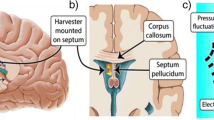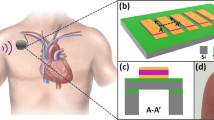Abstract
This study explores the feasibility of energy harvesting from the deformation of a piezoelectric material attached on the human mandible to power an implantable medical device such as deep brain stimulator. A finite element (FE) model of the human mandible was developed and verified experimentally. A piezoelectric energy harvesting device was designed and fixed onto a synthetic mandible to compare its experimental power output to the simulation results. A novel mandibular loading apparatus was designed to imitate the forces exerted on a mandible during mastication in a lab environment. The peak-to-peak voltages from finite element analysis (FEA) and experiment were 1.7 and 1.0 V. Despite the discrepancy in magnitude, similar voltage waveforms were obtained. A method to maximize the electrical efficiency of the proposed harvesting device was discussed.
Similar content being viewed by others
References
Deep Brain Stimulation, https://en.wikipedia.org/wiki/Deep_brain_stimulation.
K. Fakhar, E. Hastings, C. R. Butson, K. D. Foote, P. Zeil-man and M. S. Okun, Management of deep brain stimulator battery failure: Battery estimators, charge density, and importance of clinical symptoms, PLoS One, 8 (3) (2013) e58665.
M. A. Karami and D. J. Inman, Powering pacemakers from heartbeat vibrations using linear and nonlinear energy harvesters, J. Phys. Lett., 100 (4) (2012) 1–5.
M. H. Ansari and M. A. Karami, Piezoelectric energy harvesting from heartbeat vibrations for leadless pacemakers, J. Phys. Conf. Ser., 660 (1) (2015) 012121.
G. Sahara, W. Hijikata, K. Tomioka and T. Shinshi, Implantable power generation system utilizing muscle contractions excited by electrical stimulation, Proc. Inst. Mech. Eng. Part H J. Eng Med, 230 (6) (2016) 569–578.
B. E. Lewandowski, K. L. Kilgore and K. J. Gustafson, Design considerations for an implantable, muscle powered piezoelectric system for generating electrical power, Ann. Biomed. Eng, 35 (4) (2007) 631–641.
R. Yang, Y. Qin, C. Li, G. Zhu and Z. Lin Wang, Converting biomechanical energy into electricity by a muscle-movement-driven nanogenerator, Nanoletters, 9 (3) (2009) 1201–1205.
T. Starner, Human-powered wearable computing, IBM Systems Journal, 35 (1996) 618–629.
J. W. Sohn, S. B. Choi and D. Y. Lee, An investigation on piezoelectric energy harvesting for MEMS power sources, Proc. Inst. Mech. Eng. Part C J. Mech. Eng. Sci, 219 (4) (2005) 429–436.
G.-T. Hwang, Y. Kim, J.-H. Lee, S. Oh, C. K. Jeong, D. Y. Park, J. Ryu, H. Kwon, S.-G. Lee, B. Joung, D. Kim and K. J. Lee, Self-powered deep brain stimulation via a flexible PIMNT energy harvester, Energy & Environmental Science, 8 (9) (2015) 2677–2684.
M. Hosain, A. Kouzani, M. Samad and S. Tye, A miniature energy harvesting rectenna for operating a head-mountable deep brain stimulation device, IEEE Access, 3 (2015) 223–234.
L. Beker, A. Benet, A. T. Meybodi, B. Eovino, A. P. Pis-ano and L. Lin, Energy harvesting from cerebrospinal fluid pressure fluctuations for self-powered neural implants, Biomedical Microdevices, 19 (2) (2017).
A. Delnavaz and J. Voix, Flexible piezoelectric energy harvesting from jaw movements, Smart Materials and Structures, 23 (10) (2014) 105020.
M. S. Commisso, J. Martinez-Reina, J. Ojeda and J. Mayo, Finite element analysis of the human mastication cycle, J. Mech. Behav. Biomed. Mater, 41 (2015) 23–35.
J. M. Reina, J. M. Garcia-Aznar, J. Dominguez and M. Doblare, Numerical estimation of bone density and elastic constants distribution in a human mandible, J. Biomech., 40 (4) (2007) 828–836.
P. Bujtar, G. K. B. Sandor, A. Bojtos, A. Szucs and J. Barabas, Finite element analysis of the human mandible at 3 different stages of life, Oral Surgery, Oral Med. Oral Pathol. Oral Radiol. Endodontology, 110 (3) (2010) 301–309.
A. Szucs, P. Bujtar, G. K. Sandor and J. Barabas, Finite element analysis of the human mandible to assess the effect of removing an impacted third molar, J. Can. Dent. Assoc, 76 (2009) 1–7.
E. Tanaka, K. Tanne and M. Sakuda, A three-dimensional finite element model of the mandible including the TMJ and its application to stress analysis in the TMJ during clenching, Med. Eng. Phys, 16 (4) (1994) 316–322.
A. H. Choi, B. C. Ben-Nissan and R. C. Conway, Three-dimensional modelling and finite element analysis of the human mandible during clenching, Aust. Dent. J., 50 (1) (2005) 42–48.
3B Scientific, https://www.a3bs.com/.
P. Xin, P. Nie, B. Jiang, S. Deng, G. Hu and S. G. F. Shen, Material assignment in finite element modeling, J. Cranio-fac. Surg, 24 (2) (2013) 405–410.
E. Lakatos, L. Magyar and I. Bojtar, Material properties of the mandibular trabecular bone, J. Med. Eng., 2014 (2014) 1–7.
A. M. O’Mahony, J. L. Williams, J. O. Katz and P. Spencer, Anisotropic elastic properties of cancellous bone from a human edentulous mandible, Clin. Oral Implants Rex, 11 (5) (2000) 415–421.
J. B. Brunski, Mechanical properties of trabecular bone in the human mandible: Implications for dental implant treatment planning and surgical placement, J. Oral Maxillofac. Surg., 57 (6) (1999) 706–708.
S. Kayumi, Y. Takayama, A. Yokoyama and N. Ueda, Effect of bite force in occlusal adjustment of dental implants on the distribution of occlusal pressure: Comparison among three bite forces in occlusal adjustment, Int. J. Implant Dent, 1 (1) (2015) 14.
T. W. Korioth, A. G. Hannam and J. D. Res, Deformation of the human mandible during simulated tooth clenching, J Dent Res., 73 (1) (1994) 56–66.
W. L. Hylander, Functional Anatomy and Biomechanics of the Masticatory Apparatus, Quintessence Publishing Company, Batavia, USA (2006).
J. M. Po, J. A. Kieser, L. M. Gallo, A. J. Tesenyi, P. Her-bison and M. Farella, Time-frequency analysis of chewing activity in the natural environment, J. Dent. Res., 90 (10) (2011) 1206–1210.
Smart Material Corp., https://www.smart-material.com.
M. M. Omezli, D. Torul, M. E. Polat and E. Dayi, Biome-chanical comparison of osteosynthesis with poly-L-lactic acid and titanium screw in intracapsular condylar fracture fixation: An experimental study, Niger. J. Clin. Pract, 18 (5) (2015) 589–93.
S. Miyawaki, I. Koyama, M. Inoue, K. Mishima, T. Sugahara and T. Takano-Yamamoto, Factors associated with the stability of titanium screws placed in the posterior region for orthodontic anchorage, Am. J. Orthod. Dentofac. Orthop., 124 (4) (2003) 373–378.
A. Haddock, K. T. Mitchell, A. Miller, J. L. Ostrem, H. J. Chizeck and S. Miocinovic, Automated deep brain stimulation programming for tremor, IEEE Transactions on Neural Systems and Rehabilitation Engineering, 26 (8) (2018) 1618–1625.
S. Little et al., Adaptive deep brain stimulation in advanced Parkinson disease, Annals of Neurology, 74 (3) (2013) 449–-457.
J. Lee, H. Rhew, D. Kipke and M. Flynn, A 64 channel programmable closed-loop neurostimulator with 8 channel neural amplifier and logarithmic ADC, IEEE Journal of Solid-State Circuits, 45 (9) (2010) 1935–1945.
R. Cubo, M. Fahlstrom, E. Jiltsova, H. Andersson and A. Medvedev, Calculating deep brain stimulation amplitudes and power consumption by constrained optimization, Journal of Neural Engineering, 16 (1) (2019) 016020.
S. Boisseau, P. Gasnier, M. Gallardo and G. Despesse, Self-starting power management circuits for piezoelectric and electret-based electrostatic mechanical energy harvesters, J. of Physics: Conference Series, 476 (2013) 012080.
Acknowledgments
This research was supported by UMB-UMBC Research and Innovation Partnership Grant Program (2016~2017). The authors thank Mr. Danny Joh and Mr. Poojan Shah for assisting in the test setup.
Author information
Authors and Affiliations
Corresponding author
Additional information
Recommended by Associate Editor Won Hyoung Ryu
Richard Fan received an M.S. from the University of Maryland, Baltimore County (UMBC) in 2018. He is currently an Engineer at the Department of Defense where his main specialty is finite element analysis of highly dynamic events. His research interest includes biomedical application of a piezoelectronic energy harvesting device.
Soobum Lee received the Ph.D. in Mechanical Engineering, Korea Advanced Institute of Science and Technology (KAIST), Daejeon, South Korea, in 2007. He is currently an Assistant Professor with the University of Maryland Baltimore County, Baltimore MD, USA. His main research interests include energy harvesting device design, structural topology optimization, and robust and reliability-based design optimization.
Hyun Jun Jung received the Bachelor of Engineering (electrical) from Seoul National University of Science and Technology, Seoul, South Korea in 2012. He received his PhD in Electrical Engineering in Hanyang University, Seoul, South Korea, in 2017 and then he started a postdoctorate at the University of Maryland Baltimore County, Baltimore, USA. His research interests include design of piezoelectric energy harvesting device, low power management circuit, and piezoelectric transformer.
Mary Anne Melo earned her D.D.S. in 2000 from the University of Fortaleza in Ceara, Brazil, and her M.Sc. and Ph.D. in Dentistry from the Federal University of Ceara in 2012 for her work on nanotechnology-based restorative materials for dental caries management. Her primary research interests are anticaries strategies to reduce biofilm growth and acid production.
Radi Masri is an Associate Professor at the School of Dentistry and School of Medicine, University of Maryland. He is the Program Director of the Advanced Education Program in Prosthodontics and the Director of Research and Discovery Division at the Department of Advanced Oral Sciences and Therapeutics.
Rights and permissions
About this article
Cite this article
Fan, R., Lee, S., Jung, H. et al. Piezoelectric energy harvester utilizing mandibular deformation to power implantable biosystems: A feasibility study. J Mech Sci Technol 33, 4039–4045 (2019). https://doi.org/10.1007/s12206-019-0749-4
Received:
Revised:
Accepted:
Published:
Issue Date:
DOI: https://doi.org/10.1007/s12206-019-0749-4




